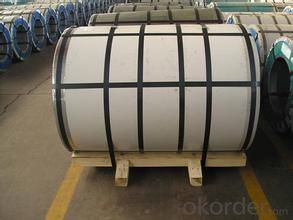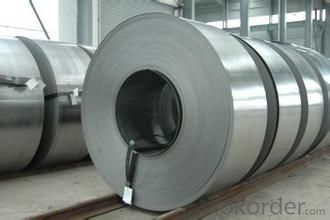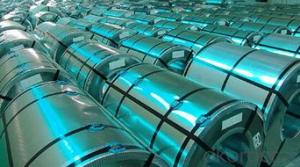Chines Best Cheap Cold Rolled Steel Coil JIS G 3302
- Loading Port:
- China main port
- Payment Terms:
- TT OR LC
- Min Order Qty:
- 50 m.t.
- Supply Capability:
- 10000 m.t./month
OKorder Service Pledge
OKorder Financial Service
You Might Also Like
Chines Best Cold Rolled Steel Coil JIS G 3302
1.Structure of Cold Rolled Steel Description:
The raw material of cold rolled steel coil/sheet is high quality hot rolled product, and after pickling continuous rolling, degreasing, annealing,skin pass,slitting and cut to length line etc. Along with it many kinds of new technology and new process of global cold rolling production have been applied. Therefore the quality of the goods could be guaranteed. The product is widely used in outdoor and interior decoration, furnishing manufacturing, home appliance, automobile etc.
2.Main Features of the Cold Rolled Steel:
• Excellent process capability
• Smooth and flat surface
• Workability, durability
• Excellent heat resistance performance
• High strength
• Good formability
• Good visual effect
3.Cold Rolled Steel Images



4.Cold Rolled Steel Specification
Standard:AISI,ASTM,DIN,GB,JIS,JIS G3302 ASTM 653M EN10142
Grade: Q195~Q345
Thickness: 0.16mm~2.0mm
Width: 1250mm MAX
Coil weight:3-12 MT
Coil ID:508/610mm
Chemical composition:
C | Si | Mn | Cr | Ni | P | S |
0.150 | 0.476 | 11.231 | 12.50 | 0.900 | 0.039 | 0.010
|
5.FAQ of Cold Rolled Steel
1.How to guarantee the quality of the products?
We have established the international advanced quality management system,every link from raw material to final product we have strict quality test;We resolutely put an end to unqualified products flowing into the market. At the same time, we will provide necessary follow-up service assurance.
2. How long can we receive the product after purchase?
Usually within thirty working days after receiving buyer’s advance payment or LC. We will arrange the factory manufacturing as soon as possible. The cargo readiness usually takes 15-25 days, but the shipment will depend on the vessel situation.
- Q:How are steel coils used in the manufacturing of doors and windows?
- Steel coils are used in the manufacturing of doors and windows as they provide the necessary strength and durability required for these products. The coils are first processed and shaped into the desired form, which is then used as the base material for constructing the frames and panels of doors and windows. The steel coils also undergo various treatments, such as galvanization or coating, to enhance their resistance to corrosion and weathering. Overall, steel coils play a crucial role in ensuring the structural integrity and longevity of doors and windows.
- Q:What are the various surface finishes available for steel coils?
- The various surface finishes available for steel coils include hot-rolled, cold-rolled, galvanized, coated, and polished finishes.
- Q:What's the best material for color coated steel coil?
- Galvanized steel sheet with hot-dip galvanized or zinc plated surface.
- Q:What are the different methods of cutting steel coils into sheets?
- There are several methods used to cut steel coils into sheets, including shearing, slitting, and laser cutting. Shearing involves using a straight blade to cut through the coil, while slitting uses circular blades to make multiple cuts simultaneously. Laser cutting, on the other hand, utilizes a high-powered laser beam to melt through the steel. Each method has its own advantages and is chosen based on factors such as the desired precision, speed, and cost-effectiveness.
- Q:Could someone please explain what happens when steel is heat treated and why these happenings cause the steel to become harder? Please dig down into the micro details of the crystallites but in somewhat laymen's terms. Also describe the processes which achieve these results; if you have the time. Thanks for your time and effort.
- Mild steel is a solution of carbon within iron, etc. When the steel is very hot the carbon is well distributed. As the steel is cooled iron crystals form excluding the carbon that will then collect at the boundaries (grain boundaries) between iron crystals. If cooling is rapid at any point in the cool down crystal growth will cease (affecting final grain size and the mix of carbon and iron at the grain boundaries). The ductility or hardness of the resulting steel will be determined by the grain sizes and makeup of the carbon/iron mix between grains. Ductile iron permits 'slabs' of iron to slip past each other within iron crystals and location of carbon atoms may help prevent slip resulting in hardness. Therefore, heat treatment usually consists of 'soaking' the steel at a temperature high enough to dissolve all the carbon uniformly then cooling it down slowly or rapidly to obtain optimum grain size and interstitial carbon between grains to obtain desired properties.
- Q:How are steel coils used in the production of metal bridges?
- Steel coils are used in the production of metal bridges as they are rolled into the desired shape and size to form the structural components of the bridge, such as beams, girders, and support structures. These coils provide the necessary strength and durability to withstand the weight and stress of the bridge, ensuring its long-term stability and safety.
- Q:Can steel coils be coated with impact-resistant materials?
- Yes, steel coils can be coated with impact-resistant materials.
- Q:How are steel coils used in the production of roofing sheets?
- Roofing sheets cannot be produced without steel coils, as they are an integral part of the manufacturing process. These coils are typically composed of high-quality steel, which is renowned for its strength, durability, and resistance to corrosion. To convert these coils into roofing sheets, several steps must be followed. To begin, the steel coils are loaded onto a machine known as a decoiler. This machine effortlessly unrolls the coils, allowing them to be fed into the production line. By doing so, the decoiler guarantees a continuous supply of steel, ensuring an uninterrupted manufacturing process. Subsequently, the steel coils pass through a series of rollers. These rollers are responsible for molding the steel into the desired shape, which is specific to the type of roofing sheet being produced. Depending on the project's requirements, the rollers can create various profiles, such as corrugated or standing seam. Once the shaping process is complete, the steel sheets often receive a protective coating. This coating, which can be zinc or other metallic alloys, is referred to as galvanized or galvalume coatings, respectively. These coatings provide an extra layer of defense against rust and corrosion. Following the application of the protective coating, the sheets are generally cut to the desired dimensions. This can be achieved using shearing machines or other cutting tools, ensuring that the roofing sheets are appropriately sized for installation. Finally, the roofing sheets are carefully packaged and prepared for transportation to construction sites. They are typically bundled together and securely wrapped to safeguard them during transit. In conclusion, steel coils play a vital role in the production of roofing sheets. Through shaping, coating, cutting, and packaging processes, these coils are transformed into finished products ready for installation. By utilizing steel coils, roofing sheets are rendered strong, durable, and resistant to various environmental factors, making them a popular choice in roofing applications.
- Q:i found a similar question asking what metals were in stainless steel but i don't know if they are the same.... they probably aren't.
- steel is iron with a little bit of carbon mixed in. how much carbon determines the hardness of the steel. stainless steel is the same mostly, it has nickle and chromium added in to make it corrosion resistant.
- Q:What are the different types of steel coil grades and specifications?
- There are several different types of steel coil grades and specifications available in the market. These grades and specifications are designed to meet various industry requirements and applications. Some of the commonly used steel coil grades and specifications are: 1. Hot Rolled Steel Coils: These coils are produced by heating the steel above its recrystallization temperature and then rolling it at a high temperature. Hot rolled steel coils are commonly used in applications where dimensional accuracy and surface finish are not critical. 2. Cold Rolled Steel Coils: Cold rolled steel coils are produced by further processing hot rolled coils through cold reduction mills. This process results in improved surface finish, tighter tolerances, and higher strength compared to hot rolled coils. Cold rolled steel coils are widely used in automotive, construction, and electrical industries. 3. Galvanized Steel Coils: Galvanized steel coils are coated with a layer of zinc to protect them from corrosion. This process, known as galvanization, enhances the durability and longevity of the steel coils. Galvanized steel coils are commonly used in applications such as roofing, fencing, and automotive body parts. 4. Stainless Steel Coils: Stainless steel coils are made from a combination of iron, chromium, and other elements that provide excellent corrosion resistance and high strength. These coils are widely used in industries such as food processing, chemical, and medical, where hygiene and corrosion resistance are critical. 5. High-strength Low-alloy (HSLA) Steel Coils: HSLA steel coils are designed to have higher strength and improved formability compared to conventional carbon steels. These coils are commonly used in structural and transportation applications, where weight reduction and high strength are required. 6. Electrical Steel Coils: Electrical steel coils, also known as silicon steel or transformer steel, are specifically designed for use in electrical equipment such as transformers, motors, and generators. These coils have low core losses and high magnetic permeability, making them ideal for efficient energy transfer. 7. Tool Steel Coils: Tool steel coils are specially formulated to have high hardness, wear resistance, and toughness. These coils are commonly used in the manufacturing of cutting tools, dies, and molds. These are just a few examples of the various types of steel coil grades and specifications available in the market. The selection of the appropriate grade and specification depends on the specific application requirements, such as strength, corrosion resistance, formability, and surface finish.
1. Manufacturer Overview |
|
|---|---|
| Location | |
| Year Established | |
| Annual Output Value | |
| Main Markets | |
| Company Certifications | |
2. Manufacturer Certificates |
|
|---|---|
| a) Certification Name | |
| Range | |
| Reference | |
| Validity Period | |
3. Manufacturer Capability |
|
|---|---|
| a)Trade Capacity | |
| Nearest Port | |
| Export Percentage | |
| No.of Employees in Trade Department | |
| Language Spoken: | |
| b)Factory Information | |
| Factory Size: | |
| No. of Production Lines | |
| Contract Manufacturing | |
| Product Price Range | |
Send your message to us
Chines Best Cheap Cold Rolled Steel Coil JIS G 3302
- Loading Port:
- China main port
- Payment Terms:
- TT OR LC
- Min Order Qty:
- 50 m.t.
- Supply Capability:
- 10000 m.t./month
OKorder Service Pledge
OKorder Financial Service
Similar products
New products
Hot products
Related keywords






























